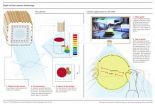The committee that wrote the report reviewed traffic safety practices and strategies in high-income countries around the world and compared them with those in the United States. From 1995 to 2009, fatalities dropped 52 percent in France, 38 percent in the United Kingdom, 25 percent in Australia, and 50 percent in 15 high-income countries for which long-term fatality and traffic data are available, but they dropped only 19 percent in the United States.
"There is a notable gap between traffic safety progress in the U.S. and other nations that deserves our attention," said Clinton V. Oster Jr., committee chair and professor, Indiana University, Bloomington. "The U.S. could learn from the effective strategies in place elsewhere to reduce traffic injuries and fatalities."
Countries most successful at reducing traffic deaths had comprehensive safety programs that include improvement in road design and traffic management; regulation of vehicle safety; and regulation of driver behaviors regarding speed, alcohol and drug use, and seat belt and motorcycle helmet use, the committee found. Furthermore, successful national programs excel at management and planning and benefit from political support and leadership. The committee noted that the most critical area for improvement in the United States today may be in management and planning, to ensure that available resources are used to greatest effect and to foster political and public support by demonstrating progress.
The report highlights essential elements of safety program management, including a plan that makes a credible commitment to the public to improve safety and regular monitoring and evaluation to determine the effects of actions taken. "These management practices have produced success in other countries," said Oster, "but are lacking in the traffic safety programs of most U.S. states."
The committee urged the U.S. Department of Transportation (DOT), in cooperation with the states, to revise its Guidelines for State Highway Safety Programs and develop a new model for state strategic highway safety plans that would specify resource requirements and the expected outcomes of safety interventions. DOT and the states should undertake a series of large-scale projects to demonstrate the design and management of effective safety initiatives. These demonstration projects are necessary, the committee concluded, because communicating the needed safety management methods to U.S. state and local agencies will require a greater level of effort than has been previously devoted to the task.
The committee also advised state legislatures to require regular reporting from the responsible executive agencies on progress in fulfilling the state's safety plan and success in meeting the plan's goals. In addition, DOT should conduct an in-depth review of social marketing methods and outcomes in other countries, and national professional organizations should create forums that bring together public administrators, legislators, and researchers for exchange of information and views on traffic safety.
Two enforcement tools widely credited with fatality reductions in other countries -- automatic enforcement of speed limits and frequent roadside sobriety checks -- are not common in the U.S because of legal restrictions, popular opposition, and cost considerations. The report estimates, on the basis of evaluations in the U.S. and other countries, that nationwide, sustained, and frequent use of sobriety checkpoints to detect drunk drivers could save 1,500 to 3,000 lives annually in the U.S.; systematic speed control programs applied nationwide could save 1,000 to 2,000 lives annually at feasible cost, even if automated enforcement is not used; enactment of universal helmet use laws by all states would avoid 450 motorcyclist deaths per year; and increasing the U.S. rate of seat belt use from the present 85 percent to 90 percent would save 1,200 lives annually. Total traffic fatalities in 2009 were 33,808 in the U.S.
###
The study was sponsored by the Transportation Research Board of the National Research Council and by the General Motors Foundation. The National Academy of Sciences, National Academy of Engineering, Institute of Medicine, and National Research Council make up the National Academies. They are private, nonprofit institutions that provide science, technology, and health policy advice under a congressional charter. The Research Council is the principal operating agency of the National Academy of Sciences and the National Academy of Engineering. For more information, visit http://national-academies.org. A committee roster follows.
Contacts:
Maureen O'Leary, Director of Public Information
Luwam Yeibio, Media Assistant
Office of News and Public Information
202-334-2138; e-mail
Additional resources:
Report in Brief
Pre-publication copies of Achieving Traffic Safety Goals in the United States: Lessons From Other Nations Transportation Research Board; tel. 202-334-3213 or on the Internet at http://www.trb.org/Finance/Bookstore.aspx. Reporters may obtain a copy from the Office of News and Public Information (contacts listed above).
NATIONAL RESEARCH COUNCIL
Transportation Research Board
Studies and Special Programs
Committee on Traffic Safety Lessons from Benchmark Nations
Clinton V. Oster Jr. (chair)
Professor and Associate Dean
School of Public and Environmental Affairs
Indiana University
Bloomington
Anthony G. Bliss
Senior Road Safety Specialist
Transport and Urban Development Department
World Bank
Washington, D.C.
William A. Bronrott
Representative
Maryland House of Delegates
Bethesda
Troy E. Costales
Administrator
Transportation Safety Division
Oregon Department of Transportation
Salem
Kent L. Cravens
Senator
New Mexico Senate
Albuquerque
John J. Cullerton
Senator
Illinois Senate
Springfield
Joseph A. Farrow
Deputy Commissioner
California Highway Patrol
Sacramento
Patrick S. McCarthy
Professor and Chair
School of Economics
Ivan Allen College
Georgia Institute of Technology
Atlanta
Alison Smiley
President
Human Factors North Inc.
Toronto, Ontario
Canada
John S. Strong
CSX Professor of Business Administration, Economics, and Finance
School of Business
College of William and Mary
Williamsburg, Va.
Richard Tay
Associate Dean of Research and
Chair in Road Safety Management
Faculty of Law and Management
La Trobe University
Bundoora, Australia
Allan F. Williams
Chief Scientist
Insurance Institute for Highway Safety (retired)
Bethesda, Md.
RESEARCH COUNCIL STAFF
Joseph Morris
Study Director
END



